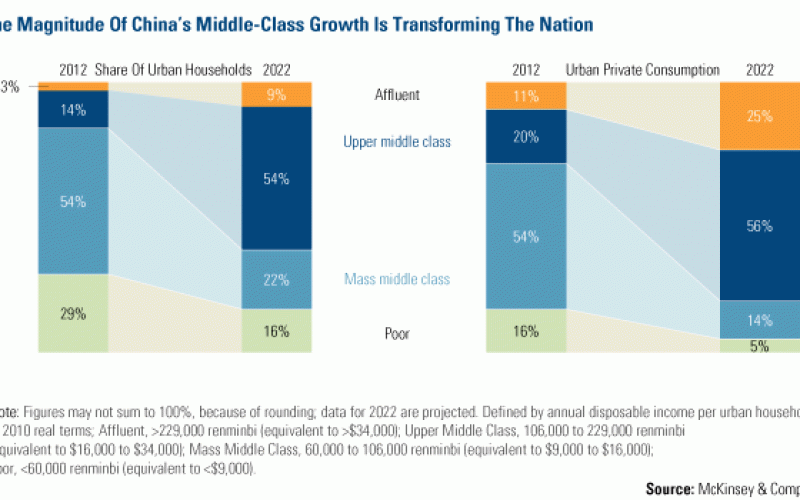By 2022, research by McKinsey suggests that 75 percent of urban consumers in China will earn around $9,000 to $34,000. This income level, which is currently between the average earned in Brazil and Italy, is only 4 percent of what Chinese households were bringing home in 2000.
 |
This major income shift is one of the 10 significant issues underlined in McKinsey’s Ten forces forging China's future. The special report gives a glimpse of what’s in store for China, and also highlights what these changes mean for investors.
McKinsey’s list includes the following:
- The Great Rebalancing: As a share of GDP, China’s household consumption is less than half of that of the U.S., raising the question of how the country will learn to balance its reliance on exports and investment with the need to increase its overall consumption.
- Infrastructure Advances: By the year 2020, China will add 43,000 kilometers of expressways, 70 airports and will expand port facilities, all contributing to China’s already-incredible 8.5 percent rise in infrastructure growth.
- The Green Challenge: Heavy smog was a visual reminder of China’s need to reduce massive energy consumption as well as create incentives for green products and services.
- Manufacturing Makeover: A new challenge for Chinese companies is to pinpoint the causes of manufacturing inefficiency by looking beyond the age-old “faster, cheaper” theory to necessary operation improvements.
- Rise of the Upper Middle Class: With a rise in wages, a wealthier upper-middle-class is emerging and will soon account for a changing consumer, one that focuses more on luxury goods or upgrades from inexpensive brands.
- E-tailing Extraordinaire: With a large impact in small and midsized cities, the e-tail market is booming, with 2012 e-tail revenues as high as $210 billion and commanding 5 to 6 percent of total retail sales.
- Innovation’s New Spark: Steering away from its title of “imitator” or “copier” of other nation’s fashions, China is beginning to make a name for itself with novel ideas, scientific research and a generation of young graduates to lead the country down a path of innovation.
- Financier to the World? China’s new economic team is faced with reforms to establish the country as a true global financial hub, following up on its already successful financial landscape, which includes its domestic financial assets of $17.4 trillion trailing that of only the U.S. and Japan.
- Investor Confidence: The abrupt fall of the stock market capitalization of Chinese companies listed in the U.S., in regards to allegations of fraud, have given the entrepreneurs in China a new challenge to finance growth and expansion.
- Cultivating Human Capital: For China to develop to its full potential, its workforce needs “better teamwork, communications and presentations skills,” says McKinsey.
McKinsey believes these issues are critical drivers for one of the world’s largest and fastest-growing economies. Read through the report to understand China’s role as a world leader, competitor and potential investment opportunity.
By clicking the link above, you will be directed to a third-party website. U.S. Global Investors does not endorse all information supplied by this website and is not responsible for its content.















